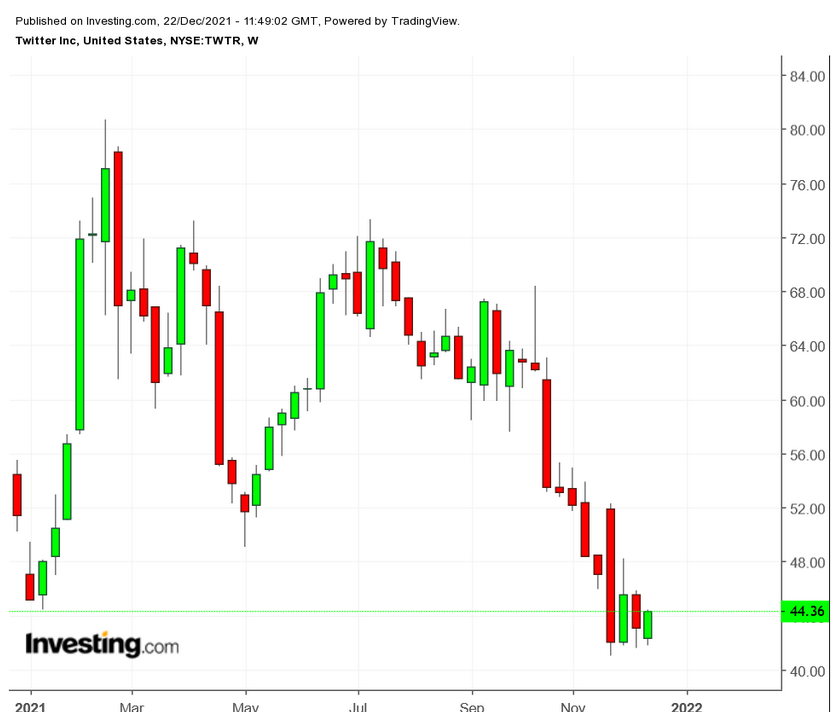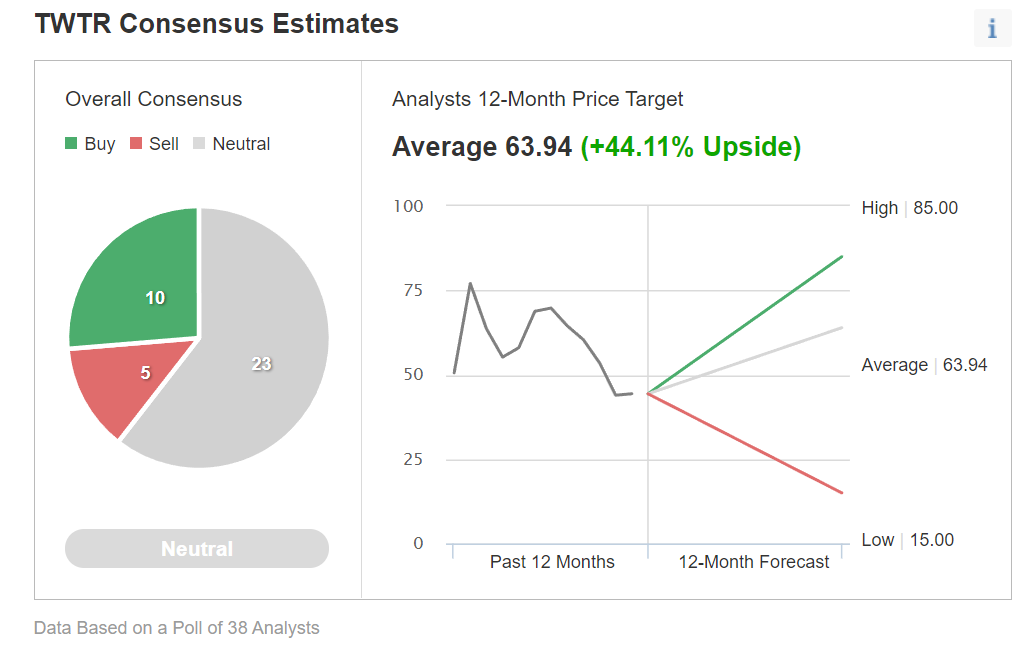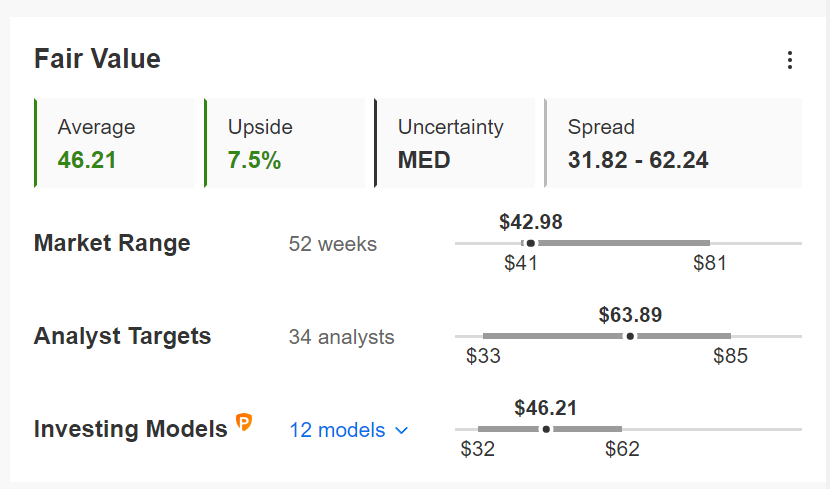For investors in the social media platform Twitter (NYSE:TWTR) 2021 hasn't been a good year. The stock is down about 19.4% year-to-date.

On Feb. 25, TWTR shares went over $80 hitting a record high. But since that high, the stock has lost about 45%; it closed yesterday at $44.37. The stock’s 52-week range has been between $41.01 - $80.75, and the market capitalization (cap) as of Tuesday is at $35.41 billion.
The San Francisco-based company released Q3 financials on Oct. 26. Revenue was $1.28 billion, compared to $936 million a year ago. Of the total revenue, $1.14 billion came from the advertising side, showing an increase of 41% YOY, and the rest of the revenue came mainly from data licensing.
Most of Twitter’s ad revenue is from services as well as digital goods. Therefore, supply chain issues that have impacted revenue for Meta Platforms (NASDAQ:FB) or Snap (NYSE:SNAP) have not negatively affected Twitter.
Adjusted earnings came in at 18 cents vs. analysts’ expectation of 15 cents. Meanwhile, Twitter’s monetizable daily active users (mDAU) came in 211 million, an increase of 13% from a year ago.
The company’s Q4 2021 revenue guidance is in the $1.5-$1.6 billion range. Prior to the release of the quarterly results in late October, TWTR shares were trading at the $60 level. As we write, they're hovering around $44.
As well, since then, the platform’s co-founder, Jack Dorsey, has stepped down as CEO. Now Parag Agrawal, who used to be the chief technology officer, is at the helm. Going forward, Agrawal is expected to put more emphasis on blockchain technologies.
What To Expect From TWTR Stock
Among 38 analysts polled via Investing.com, Twitter stock received a “neutral" rating.

Chart: Investing.com
Analysts also have a 12-month median price target of $63.94 on the stock, implying an increase of over 63% from current levels. The 12-month price range currently stands between $15.00 and $85.00.
However, according to a number of valuation models, such as those that might consider P/E multiples or the 10-year Discounted Cash Flow (DCF) growth exit method, the average fair value for TWTR stock stands at $46.20, implying an upside potential of 7.5%, i.e., a more modest price appreciation from where the stock is now.

Chart: InvestingPro
Moreover, we can look at the company’s financial health determined by ranking it on more than 100 factors against peers in the Communication Services sector. In terms of growth, cash flow and price momentum health, Twitter scores 3 out of 5 (top score). Its overall performance is also ranked at 3 (“fair”).
P/B and P/S ratios for TWTR stock are 4.9x and 7.3x, respectively. By comparison, those metrics for peers stand at 4.4x and 3.5x.
Finally, readers who watch technical charts might be interested to know that several of TWTR stock’s short- and intermediate-term indicators are giving oversold signals. In other words, the decline in shares could soon be coming to a halt.
Given the recent significant drop in price, our first expectation is for TWTR stock to begin to stabilize in the coming days, and trade in a range, possibly between $40 and $45. Once Twitter stock establishes a new base, a leg up is likely to start.
Cash-Secured Put Selling
Investors who believe TWTR stock could trade sideways or even start moving up in the weeks ahead might consider selling a cash-secured put option in Twitter stock—a strategy we regularly cover. As it involves options, this set-up will not be appropriate for all investors.
Let's assume an investor wants to buy Twitter stock, but does not want to pay the full price of $44.37 per share. Instead, the investor would prefer to buy the shares at a discount within the next several months.
One possibility would be to wait for TWTR stock to fall, which it might or might not do. The other possibility is to sell one contract of a cash-secured Twitter put option.
So the trader would typically write an at-the-money (ATM) or an out-of-the-money (OTM) put option and simultaneously set aside enough cash to buy 100 shares of the stock.
Let's assume the trader is putting on this trade until the option expiry date of 18 Feb. 2022. As the stock is $44.37, an OTM put option would have a strike of $40.00.
Thus the seller would have to buy 100 shares of TWTR at the strike of $40.00 if the option buyer were to exercise the option to assign it to the seller.
The TWTR 18 Feb. 2022 40.00-strike put option is currently offered at a price (or premium) of $2.15.
An option buyer would have to pay $2.15 X 100, or $215, in premium to the option seller. This premium amount belongs to the option seller no matter what happens in the future. The put option will stop trading on Friday, Feb. 18.
The seller's maximum gain is this premium amount if TWTR stock closes above the strike price of $40.00. Should that happen, the option expires worthless.
If the put option is in the money (meaning the market price of Twitter stock is lower than the strike price of $40.00) any time before or at expiration on Feb. 18, this put option can be assigned. The seller would then be obligated to buy 100 shares of Twitter stock at the put option's strike price of $40.00 (i.e., at a total of $4,000).
The break-even point for our example is the strike price ($40.00) less the option premium received ($2.15), i.e., $37.85. This is the price at which the seller would start to incur a loss.
Cash-secured put selling is a moderately more conservative strategy than buying shares of a company outright at the current market price. This can be a way to capitalize on any choppiness in Twitter stock in the coming weeks.
Investors who end up owning TWTR shares as a result of selling puts could further consider setting up covered calls to increase the potential returns on their shares. Thus, selling cash-secured puts could be regarded as the first step in stock ownership.
